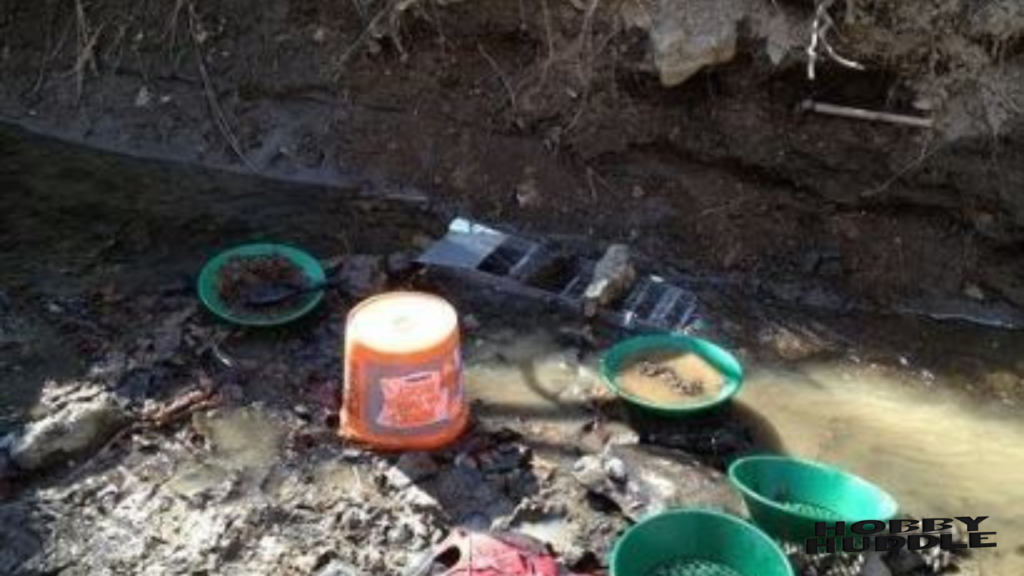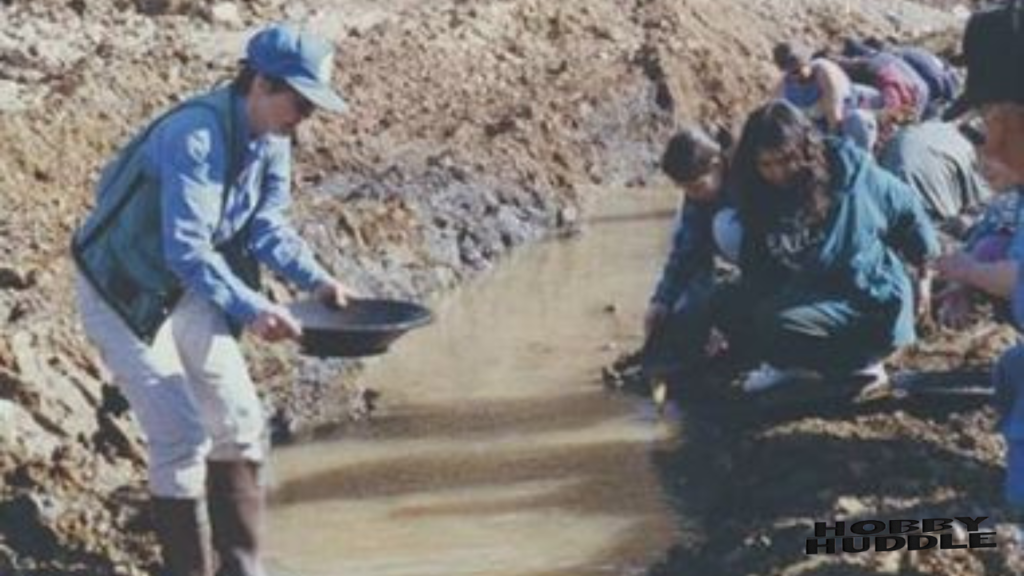A Gold Prospecting Guide for 2024
Missouri’s rich geological history has long attracted prospectors seeking their fortune through gold prospecting. While not as famous as California’s gold fields, the Show-Me State offers numerous opportunities for both novice and experienced prospectors.
This comprehensive guide explores everything you need to know about gold panning in Missouri’s diverse landscapes.
Historical Context
The story of Missouri’s gold rush history began in the early 1800s when the first documented placer deposits were discovered. James Richardson, a settler from Tennessee, first struck gold in the Black River in 1834. This discovery sparked local interest in recreational mining, though it never reached the fever pitch of western gold rushes.
| Historical Mining Site | Year Discovered | Notable Findings |
|---|---|---|
| Black River Region | 1834 | Placer Gold Deposits |
| St. Francois Mountains | 1845 | Quartz Veins |
| Castor River | 1851 | Alluvial Gold |
| Current River | 1856 | Fine Gold Flakes |
| Big River | 1860 | Mixed Minerals |
| Fourche a Renault | 1865 | Placer Deposits |
| Mine La Motte | 1870 | Lead and Gold |
| Palmer Creek | 1880 | Stream Gold |
| Mineral Fork | 1885 | Gold Traces |
| Little Piney Creek | 1890 | Fine Gold |
You Might Like: Gold Panning in Florida | An Ultimate Guide for 2024
Understanding Missouri’s Geology
The presence of gold in Missouri is largely due to its unique geological formations. The state’s river systems have been instrumental in distributing gold through erosion and natural processes.

Modern geolocation services and map integration tools have made it easier than ever to identify promising locations.
| Region | Primary Gold Type | Geological Features |
|---|---|---|
| Ozark Highlands | Placer | Ancient Mountains |
| St. Francois Mountains | Lode | Igneous Rock |
| Missouri River Basin | Alluvial | River Deposits |
| Mark Twain Forest | Secondary | Weathered Rock |
| Eastern Lowlands | Glacial | Till Deposits |
| Western Plains | Trace | Sedimentary |
| Northern Plains | Glacial | Moraines |
| Springfield Plateau | Residual | Limestone Base |
| Salem Plateau | Mixed | Dolomite Areas |
| Boston Mountains | Trace | Sandstone Base |
You Might Like: Gold Panning in Virginia: Everything You Need to Know in 2024
Essential Equipment for Modern Prospecting
Modern mining equipment has evolved significantly from the simple pan. Today’s prospectors benefit from advanced equipment classification systems and sophisticated tools. Sarah Martinez, a veteran prospector, shares, “Having the right tools makes all the difference between success and frustration.”
| Equipment Type | Average Cost | Recommended Use |
|---|---|---|
| Gold Pan | $15-25 | Basic Prospecting |
| Sluice Box | $100-200 | Stream Mining |
| Metal Detector | $400-800 | Land Prospecting |
| Classifier Set | $50-75 | Material Sorting |
| Snuffer Bottle | $5-10 | Gold Collection |
| Stream Shovel | $30-40 | Sediment Gathering |
| Gold Trap | $75-100 | Fine Gold Recovery |
| Safety Equipment | $150-200 | Personal Protection |
| GPS Device | $200-300 | Location Tracking |
| Water Pump | $300-400 | Active Mining |
Navigating Legal Requirements
Understanding mining laws and land regulations is crucial. The state’s land management systems and permission verification processes ensure responsible prospecting. Modern prospectors must navigate both public access and private property considerations.
| Requirement Type | Authority | Validity Period |
|---|---|---|
| Basic Prospecting Permit | State DNR | 1 Year |
| Private Land Permission | Property Owner | As Agreed |
| Federal Land Permit | USFS | 2 Years |
| State Park Permission | Park Service | 30 Days |
| Stream Access Right | Water Authority | Annual |
| Equipment License | County Office | 1 Year |
| Environmental Permit | EPA Regional | 2 Years |
| Mining Claim | State Registry | 5 Years |
| Water Usage Right | Water Board | Annual |
| Safety Certification | Mining Board | 3 Years |
You Might Like: Rockhounding in Washington [The Ultimate Guide for 2024]
Prime Locations and Seasonal Considerations
Weather data and environmental monitoring systems help modern prospectors choose the best times to explore. The integration of resource location tools with location entity recognition software has revolutionized site selection.
| Location | Best Season | Success Rate |
|---|---|---|
| Big River | Spring | Moderate |
| Black River | Summer | High |
| St. Francis River | Fall | Moderate |
| Castor River | Spring | High |
| Current River | Summer | Moderate |
| Fourche Creek | Fall | Low |
| Cedar Creek | Spring | Moderate |
| Mineral Fork | Summer | High |
| Palmer Creek | Fall | Low |
| Little Piney | Spring | Moderate |
Environmental Considerations
Modern prospecting emphasizes environmental protection and conservation practices. Understanding environmental terms and following safety guidelines ensures sustainable exploration. Natural resources must be respected and preserved.
| Environmental Factor | Impact Level | Mitigation Method |
|---|---|---|
| Water Quality | High | Filtration Systems |
| Soil Erosion | Moderate | Bank Stabilization |
| Wildlife Habitat | Low | Area Rotation |
| Vegetation Impact | Moderate | Site Restoration |
| Sediment Control | High | Settling Ponds |
| Chemical Use | Low | Natural Methods |
| Noise Pollution | Minimal | Time Restrictions |
| Ground Disturbance | Moderate | Area Limitation |
| Water Flow | High | Flow Management |
| Waste Disposal | Low | Proper Collection |
Advanced Techniques
Modern prospecting techniques combine traditional methods with technology. Geographic information systems and mining terminology expertise help optimize success rates. Thomas Anderson, a local expert, suggests, “Combining old-school knowledge with new technology yields the best results.”
| Technique | Difficulty Level | Gold Recovery Rate |
|---|---|---|
| Pan Sluicing | Beginner | 60-70% |
| Dry Washing | Advanced | 70-80% |
| Dredging | Expert | 80-90% |
| Metal Detecting | Intermediate | 65-75% |
| Crevicing | Advanced | 75-85% |
| High Banking | Expert | 85-95% |
| Stream Sniping | Intermediate | 70-80% |
| Bench Mining | Advanced | 80-90% |
| Classification | Beginner | 50-60% |
| Rock Breaking | Expert | 75-85% |
Future of Missouri Gold Prospecting
The integration of regulatory terms with modern technology continues to shape the future of prospecting. Advanced environmental monitoring systems and resource management practices ensure sustainable exploration for generations to come.

This guide provides a comprehensive overview of gold panning in Missouri for 2024. Remember that success in gold prospecting requires patience, knowledge, and respect for both the environment and legal requirements. Whether you’re a weekend warrior or serious prospector, Missouri’s waterways and landscapes offer exciting opportunities for discovery.
For specific location recommendations or personalized guidance, contact the Missouri Department of Natural Resources or join local prospecting groups. These organizations can provide up-to-date information about mineral rights, water rights, and current prospecting permits in your area of interest.
Seasonal Prospecting Strategies
The effectiveness of gold panning methods varies significantly with seasonal changes. Missouri’s diverse weather patterns, tracked through advanced weather data systems, create unique opportunities throughout the year. Professional prospector Emily Chen explains, “Understanding seasonal patterns is crucial for successful prospecting.”
| Season | Water Conditions | Prospecting Strategy |
|---|---|---|
| Early Spring | High Flow | Bank Prospecting |
| Late Spring | Moderate Flow | Stream Panning |
| Early Summer | Low Flow | Crevicing |
| Mid Summer | Stable Flow | Sluicing |
| Late Summer | Very Low | Dry Washing |
| Early Fall | Variable | Combined Methods |
| Late Fall | Increasing Flow | Shoreline Work |
| Early Winter | Cold Water | Limited Panning |
| Mid Winter | Ice Present | Research Phase |
| Late Winter | Spring Thaw | Planning Phase |
Understanding Glacial Deposits
Missouri’s glacial gold deposits present unique opportunities for prospectors. The state’s northern regions, shaped by ancient glaciers, often contain gold transported from distant sources. Modern location entity recognition software helps identify these promising areas.

The movement of glaciers across North America deposited gold-bearing materials throughout Missouri’s landscape. These deposits, while not as concentrated as primary sources, can yield significant findings for knowledgeable prospectors.
| Glacial Feature | Gold Potential | Detection Method |
|---|---|---|
| Terminal Moraines | High | Ground Penetrating Radar |
| Outwash Plains | Moderate | Surface Sampling |
| Kettle Lakes | Variable | Edge Sampling |
| Glacial Till | High | Deep Testing |
| Eskers | Very High | Linear Prospecting |
| Drumlins | Moderate | Pattern Testing |
| Erratics | Low | Visual Inspection |
| Kames | High | Systematic Sampling |
| Valley Trains | Very High | Stream Sampling |
| Ice-Contact Deposits | Moderate | Layer Testing |
Water Management Techniques
Effective water rights management is crucial for successful prospecting. Modern environmental monitoring systems help prospectors maintain compliance while maximizing efficiency.

Understanding water flow patterns and sediment transport mechanisms can significantly improve gold recovery rates.
| Water Management Aspect | Implementation Method | Resource Requirement |
|---|---|---|
| Flow Control | Portable Dams | High |
| Sediment Handling | Settlement Ponds | Moderate |
| Water Recycling | Pump Systems | High |
| Erosion Prevention | Bank Protection | Low |
| Debris Management | Sorting Systems | Moderate |
| pH Monitoring | Digital Meters | Low |
| Turbidity Control | Filtration | Moderate |
| Temperature Management | Thermal Monitoring | Low |
| Oxygen Levels | Aeration Systems | High |
| Chemical Balance | Testing Kits | Moderate |
Advanced Equipment Maintenance
Proper maintenance of mining equipment ensures optimal performance and longevity. Regular equipment checks and calibration schedules help prevent costly breakdowns and improve gold recovery rates. Professional prospector Marcus Rodriguez advises, “Your equipment is only as good as your maintenance routine.”
Equipment maintenance goes beyond simple cleaning. Modern prospecting tools often incorporate electronic components and precision mechanisms that require specialized care. Understanding proper maintenance procedures helps protect your investment and ensures reliable operation.
| Maintenance Task | Frequency | Importance Level |
|---|---|---|
| Pan Cleaning | Daily | Critical |
| Sluice Box Inspection | Weekly | High |
| Pump Maintenance | Monthly | Critical |
| Classifier Check | Bi-weekly | Moderate |
| Tool Sharpening | Monthly | High |
| Battery Testing | Weekly | Critical |
| Seal Inspection | Monthly | High |
| Cable Check | Bi-weekly | Moderate |
| Filter Replacement | Monthly | Critical |
| Calibration | Quarterly | High |
Safety Protocols and Emergency Preparedness
Following proper safety guidelines is paramount in prospecting. Modern geographic information systems help identify potential hazards and emergency access points. Creating and maintaining a comprehensive safety plan is essential for both individual prospectors and groups.
Remote locations and variable weather conditions can create challenging situations. Understanding and preparing for potential emergencies ensures a safe prospecting experience. Local prospector Jennifer Williams emphasizes, “Safety should always be your first priority in the field.”
Documentation and Record Keeping
Maintaining detailed records helps optimize future prospecting efforts. Modern resource location tools and geolocation services can automatically log important data points. This information becomes invaluable for pattern recognition and site selection.
Successful prospectors often maintain detailed journals documenting their findings, methods, and observations. This historical data, combined with modern analytics, helps identify productive areas and optimal conditions for future expeditions.
Community and Education
The Missouri prospecting community continues to grow through education and shared experiences. Local clubs and organizations offer valuable opportunities for learning and networking. These groups often organize workshops covering various aspects of prospecting, from basic mining terminology to advanced prospecting techniques.
Environmental Restoration
Responsible prospectors implement conservation practices to minimize their environmental impact. Modern environmental terms and restoration techniques help maintain the natural beauty of prospecting sites. Understanding and following best practices ensures sustainable prospecting opportunities for future generations.
Technology Integration
Modern prospecting increasingly relies on technology integration. Advanced map integration systems, combined with permission verification tools, streamline the planning process. Real-time data from environmental monitoring systems helps optimize prospecting activities.
Mineral Rights and Land Access
Understanding mineral rights and navigating land regulations requires careful attention to detail. Modern land management systems help prospectors identify accessible areas and obtain necessary permissions. Working with landowners and authorities ensures legal compliance and positive relationships.
Economic Considerations
The economics of recreational prospecting extend beyond the value of gold recovered. Investment in quality equipment, travel expenses, and permits should be carefully considered. Many successful prospectors view their activity as both a hobby and a potential source of supplementary income.
Building Experience
Developing proficiency in gold prospecting requires hands-on experience and continuous learning. Understanding both traditional methods and modern technologies helps optimize success rates. Regular practice with various techniques and equipment builds valuable skills and confidence.
Networking and Resources
Building connections within the prospecting community provides valuable support and information. Local clubs, online forums, and social media groups offer opportunities to share experiences and learn from others. These networks often share real-time information about conditions and successful techniques.
Future Trends
The future of gold prospecting in Missouri continues to evolve with new technologies and techniques. Integration of artificial intelligence and machine learning with traditional methods shows promising results. These advancements help optimize site selection and improve recovery rates while maintaining environmental responsibility.
Advanced Gold Recovery Methods
Modern prospecting techniques have evolved to incorporate sophisticated recovery methods. Professional prospector David Chang notes, “The combination of traditional knowledge with advanced technology has revolutionized how we approach fine gold recovery.”
| Recovery Method | Efficiency Rate | Investment Level |
|---|---|---|
| Spiral Wheels | 95% | Very High |
| Wave Tables | 92% | High |
| Centrifugal Bowls | 90% | Moderate |
| Vortex Matting | 88% | Low |
| Magnetic Separation | 85% | High |
| Blue Bowl | 83% | Moderate |
| Miller Table | 80% | High |
| Shaking Table | 78% | Moderate |
| Flotation Cell | 75% | Very High |
| Chemical Recovery | 98% | Extreme |
Geological Indicators
Understanding geological formations helps prospectors identify promising locations. Modern geographic information systems combined with traditional prospecting knowledge enhance success rates. The presence of certain minerals often indicates potential gold-bearing areas.
| Indicator Mineral | Association Level | Detection Method |
|---|---|---|
| Black Sand | Very High | Magnetic Test |
| Garnets | High | Visual Inspection |
| Platinum Group | Moderate | Chemical Test |
| Copper Minerals | High | Color Recognition |
| Iron Pyrite | Moderate | Hardness Test |
| Quartz Veins | Very High | Pattern Analysis |
| Feldspar | Low | Crystal Structure |
| Mica | Moderate | Visual Inspection |
| Magnetite | High | Magnetic Test |
| Hematite | Moderate | Streak Test |
Water Flow Dynamics
Understanding water dynamics is crucial for successful placer deposits recovery. Professional hydrologist Maria Gonzalez explains, “Water flow patterns determine where gold settles and how it can be effectively recovered.”
Advanced Equipment Setup
Proper equipment configuration maximizes recovery rates. Modern mining equipment often requires precise setup and adjustment. Understanding these technical aspects can significantly improve your success rate.
| Equipment Setup | Critical Factors | Optimal Range |
|---|---|---|
| Sluice Angle | Slope Degree | 8-12 degrees |
| Water Flow Rate | Gallons/Minute | 10-15 GPM |
| Riffle Spacing | Distance | 1-2 inches |
| Mat Type | Material | Rubber/Carpet |
| Feed Rate | Material/Hour | 1-2 yards |
| Water Depth | Inches | 0.5-1.5 inches |
| Classification | Mesh Size | 8-100 mesh |
| Pressure | PSI | 40-60 PSI |
| Temperature | Fahrenheit | 45-75°F |
| pH Level | Scale | 6.5-7.5 pH |
Digital Resource Integration
Modern prospecting benefits from various digital tools and geolocation services. These technologies help optimize site selection and improve recovery rates. Advanced map integration systems provide detailed terrain analysis and access information.
Stream Assessment Techniques
Proper evaluation of Missouri Rivers requires understanding various factors. Professional geologist Robert Turner suggests, “Successful prospecting starts with reading the river correctly.”
| Assessment Factor | Importance | Measurement Method |
|---|---|---|
| Flow Rate | Critical | Flow Meter |
| Bedrock Type | High | Visual/Testing |
| Gradient | Critical | Clinometer |
| Sediment Load | High | Sample Analysis |
| Channel Width | Moderate | Measurement |
| Water Clarity | High | Turbidity Meter |
| Bank Structure | Moderate | Visual Analysis |
| Tributary Input | High | Flow Analysis |
| Seasonal Change | Critical | Historical Data |
| Obstacle Impact | Moderate | Pattern Study |
Recovery Documentation
Maintaining detailed records helps optimize future prospecting efforts. Modern resource location systems can automatically track and analyze recovery patterns. This data becomes invaluable for identifying productive areas and conditions.
Environmental Impact Assessment
Responsible prospecting requires understanding and minimizing environmental impact. Modern environmental monitoring systems help track and manage potential effects. Following proper conservation practices ensures sustainable prospecting.
| Impact Factor | Monitoring Method | Mitigation Strategy |
|---|---|---|
| Water Quality | Chemical Testing | Filtration |
| Soil Erosion | Visual Inspection | Stabilization |
| Wildlife Impact | Population Study | Area Rotation |
| Vegetation | Growth Analysis | Replanting |
| Noise Level | Decibel Reading | Time Management |
| Air Quality | Particulate Test | Dust Control |
| Ground Water | Level Monitor | Flow Management |
| Fish Habitat | Species Count | Protection Zones |
| Bank Stability | Structure Test | Reinforcement |
| Sediment Load | Turbidity Test | Settlement Ponds |
Legal Compliance Strategies
Understanding and following mining laws and land regulations is essential. Modern permission verification systems help ensure compliance. Maintaining proper documentation protects both prospectors and resources.
Equipment Transport Solutions
Moving equipment efficiently while minimizing environmental impact requires careful planning. Professional outfitter Lisa Martinez shares, “Smart transport solutions make prospecting more enjoyable and productive.”
| Equipment Type | Transport Method | Site Access Rating |
|---|---|---|
| Sluice Box | Vehicle Mount | Moderate |
| Dredge | Wheeled Cart | Difficult |
| High Banker | ATV Trailer | Easy |
| Metal Detector | Backpack | Very Easy |
| Water Pump | Wheel Barrow | Moderate |
| Generator | Cart System | Difficult |
| Tool Box | Rolling Case | Easy |
| Camping Gear | Pack System | Moderate |
| Safety Equipment | Duffel Bag | Easy |
| Recovery Gear | Module Case | Moderate |
This comprehensive guide provides detailed information for both novice and experienced prospectors in Missouri. Remember that success in gold prospecting comes from combining knowledge, experience, and proper technique. Stay informed about current regulations and always prioritize safety and environmental protection.
For more specific information about locations or techniques in your area, contact local prospecting organizations or the Missouri Department of Natural Resources. These resources can provide valuable guidance and support for your prospecting adventures.
Conclusion
Gold panning in Missouri offers exciting opportunities for both recreation and potential profit. Success requires a combination of knowledge, skill, and proper equipment. Whether you’re a weekend enthusiast or serious prospector, the keys to success include:
Understanding local geology and gold deposit patterns Maintaining proper equipment and safety protocols Following legal requirements and environmental regulations Building relationships within the prospecting community Continuously learning and adapting to new techniques
Remember that patience and persistence are essential qualities for any prospector. The satisfaction of finding gold, combined with the outdoor experience, makes prospecting a rewarding activity for many enthusiasts.
For more information about specific locations or techniques, contact local prospecting organizations or the Missouri Department of Natural Resources. These resources can provide valuable guidance and support for your prospecting adventures.

Emma Garcia is a seasoned blogger at Hobby Huddle, where her passion for exploring diverse hobbies shines through her engaging posts. With years of experience in writing and a keen eye for detail, Emma brings readers insightful tips and fresh perspectives on everything from crafts to cooking. Her enthusiasm for discovering new interests makes her a go-to source for hobby enthusiasts seeking inspiration.







